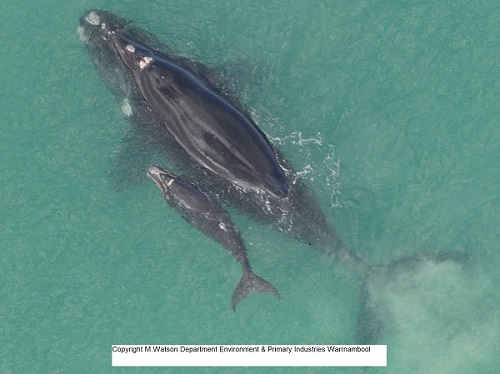 Species information
Species information
The Southern Right Whale is a large baleen whale that can grow to 18 m in length and weigh up to 80 tonnes. Its skin is black, occasionally grey or with white patches on the belly and it is the only large whale that lacks a dorsal fin. The Southern Right Whale has one of the largest heads of all whale species, measuring up to one-third its body length, and it has a highly arched mouth. The Southern Right Whale is also distinguished by the roughened skin patches on the head, known as callosities, which become colonised by tiny white crustaceans called cyamids. These features are important as they allow scientists to tell individual whales apart.
The Southern Right Whale is a migratory species which spends the warmer months in the sub-antarctic oceans and the cooler months along the southern coastline of Australia where females come to give birth and nurse their young.
Threats
Key threats to Southern Right Whales are vessel disturbance, vessel strike, underwater noise disturbance, entanglement with fishing ropes and global warming.
What's being done?
Efforts to save the species are being supported by a $48,000 grant through the Victorian Government’s Biodiversity On-Ground Action Icon Species Grants program, which funds targeted actions designed to protect and conserve Victoria’s threatened species.
This funding is going towards a study to investigate threat mitigation tools and develop recommendations for a range of actions to support the recovery of the Endangered Southern Right Whale in in Victoria such as:
- Flexible vessel exclusion zones and speed restrictions and regulation of commercial fishing techniques
- Protection of breeding females and calves at wintering locations along the coast which will be critical for population recovery
- Use of technology such as passive acoustic monitoring (PAM) to inform mitigation actions.
Whales are protected from commercial whaling by the International Convention for the Regulation of Whaling through the moratorium on commercial whaling implemented in 1986.
The Southern Right Whale is afforded a degree of international protection through its listing on Appendix I of the Convention on International Trade in Endangered Species (CITES), Appendix I of the Convention on the Conservation of Migratory Species of Wild Animals (CMS).
The EPBC Act established the Australian Whale Sanctuary and gives high levels of protection to cetaceans in Commonwealth waters. The Australian Whale Sanctuary encompasses the area of the Australian Exclusive Economic Zone (EEZ) outside state waters and generally extends 200 nautical miles from the coast.
Whale watching guidelines have been incorporated into the Victorian Wildlife (Marine Mammals) Regulations 2019 to provide for long-term protection of whales by prescribing minimum approach distances to whales, prohibiting or regulating activities in the vicinity of whales and prescribing conditions and setting fees for whale watching tour permits.
The Logans Beach Exclusion Zone is a defined offshore area near Warrnambool, closed to powered vessels each year to protect females and their nursing calves during the Southern Right Whale breeding season . The area is listed as an Exclusion Zone under the Wildlife Act 1975.
Who's helping?
Conserving Victoria's threatened species requires a collaborative approach. Organisations and individuals currently working to protect the Southern Right Whale in Victoria include:
- The Department of Environment Land Water and Planning (DELWP)
- Barwon South West Region, DELWP
- Arthur Rylah Institute, DELWP
- Federation University
- Local Government authorities along the coast
- Deakin University Warrnambool - Logans Beach whale watchers
- Whale watching volunteers and citizen scientist photographers contributing to the Southern Right Whale Photo Identification project via WhaleFace
Resources
Page last updated: 29/06/21